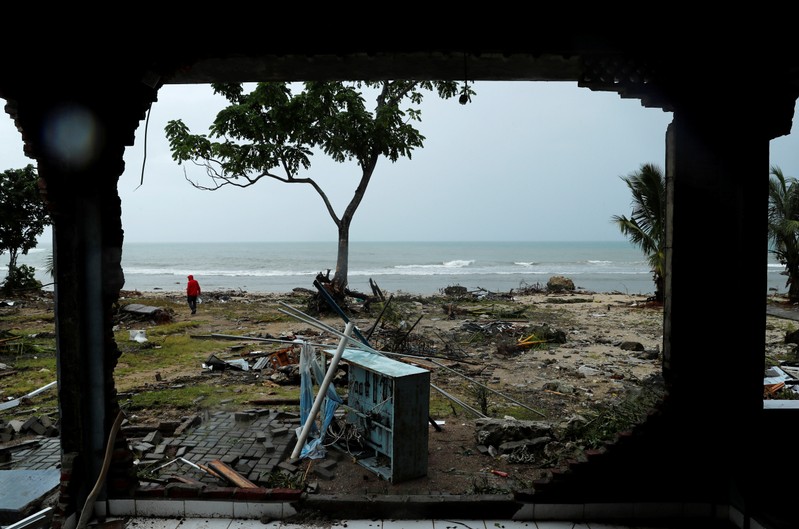
Debris is seen along a beach after a tsunami, near Sumur, Banten province, Indonesia December 26, 2018. REUTERS/Jorge Silva
December 26, 2018
By Fergus Jensen
TANJUNG LESUNG, Indonesia (Reuters) – Indonesian authorities warned on Wednesday of “extreme weather and high waves” around the erupting Anak Krakatau volcano, urging people to stay away from the coast already devastated by a tsunami that killed more than 400 people.
Clouds of ash spewed from Anak Krakatau, almost obscuring the volcanic island where a crater collapse at high tide on Saturday sent waves up to 5 meters (16 feet) high smashing into the coast on the Sunda Strait, between Java and Sumatra islands.
Indonesia’s meteorology agency (BMKG) said late on Tuesday the rough weather around the volcano could make its crater more fragile.
“We have developed a monitoring system focused specifically on the volcanic tremors at Anak Krakatau so that we can issue early warnings,” said BMKG head Dwikorita Karnawati, adding that a two-kilometer exclusion zone had been imposed.
(GRAPHIC: Indonesia tsunami disaster zone – https://tmsnrt.rs/2RdjsMd)
The confirmed death toll is 429, with at least 154 people missing. More than 1,400 people were injured and thousands of people have moved to higher ground.
The vast archipelago, which sits on the Pacific “Ring of Fire”, has suffered its worst annual death toll from disasters in more than a decade.
The latest disaster, coming during the Christmas season, evoked memories of the Indian Ocean tsunami triggered by an earthquake on Dec. 26, 2004, which killed 226,000 people in 14 countries, including more than 120,000 in Indonesia.
The Saturday evening tsunami followed the collapse of an area of the volcano island of about 64 hectares (222 acres), or about 90 soccer pitches.
The waves generated engulfed fishing villages and holiday beach parties at resorts, leaving a coast littered with crushed vehicles, felled trees. Chunks of metal, wooden beams and household items have been strewn across roads and rice fields.
In 1883, the volcano then known as Krakatoa erupted in one of the biggest blasts in recorded history, killing more than 36,000 people in a series of tsunami, and lowering the global surface temperature by one degree Celsius with its ash.
Anak Krakatau (child of Krakatau) is the island that emerged from the area in 1927, and has been growing ever since.
Rescuers were trying on Wednesday to reach several villages still inaccessible by road.
Thousands of people are staying in tents and temporary shelters like mosques or schools, with dozens sleeping on the floor or in crowded public facilities.
Ayub, a 20-year old fisherman sleeping with his family in a tent provided by the military, said conditions were not ideal due to the rain, but that they had enough to eat.
“Everything is destroyed … My boat, motorcycle, house – all of it,” he told Reuters.
“The most important thing is we’re alive.”
(Additional reporting by Bernadette Christina Munthe, Fanny Potkin, Tabita Diela, Wilda Asmarini, Nilufar Rizki in JAKARTA; Writing by Kanupriya Kapoor,; Editing by xx)

